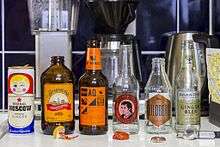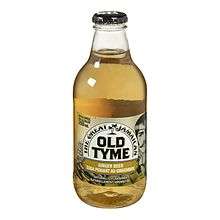Ginger beer

Traditional ginger beer is a naturally sweetened and carbonated, non alcoholic beverage. It is produced by the natural fermentation of prepared ginger spice, yeast and sugar.
Its origins date from the colonial spice trade with the Orient and the sugar producing islands of the Caribbean.[1] It was popular in Britain and its colonies from the 18th century. Other spices were variously added and any alcohol content was limited to 2% by excise tax laws in 1855.[2] Few brewers have maintained an alcoholic product.[3]
Current ginger beers are often manufactured rather than brewed, frequently with flavor and color additives. Ginger ales are not brewed.
Ginger beer is still produced at home using a symbiotic colony of yeast and a Lactobacillus (bacteria) known as a "ginger beer plant".
Ginger beer has experienced a marked increase in popularity in recent years accompanying the popularity of cocktails based on it, such as the Moscow Mule and the Dark 'N' Stormy.[4]
History
As early as 500 BC, ginger was used as a medicine and for flavouring food in Ancient China and India. In the western hemisphere, ginger was used to spice up drinks. During the Victorian era, it was used to brew an alcoholic beverage termed "ginger beer".[5]
Brewed ginger beer originated in Yorkshire in England in the mid-18th century[6] and became popular throughout Britain, the United States, Ireland, South Africa and Canada, reaching a peak of popularity in the early 20th century.[7]
Brewed ginger beer was brought to the United States of the Ionian Islands by the British Army in the 19th century, and is still made as a local specialty known as tsitsibíra (τσιτσιμπίρα) by villagers in rural Corfu.[8]
Production
Ginger beer plant
The Ginger beer plant (GBP) is not what is usually considered a plant but a composite organism consisting of a fungus, the yeast Saccharomyces florentinus (formerly S. pyriformis) and the bacterium Lactobacillus hilgardii (formerly Brevibacterium vermiforme),[9][10] which form a symbiotic colony of bacteria and yeast (SCOBY). It forms a gelatinous substance that allows it to be easily transferred from one fermenting substrate to the next, much like kefir grains, kombucha, and tibicos.[11]

The GBP was first described by Harry Marshall Ward in 1892, from samples he received in 1887.[10][12][13][14] Original ginger beer is made by leaving water, sugar, ginger, and GBP to ferment. GBP may be obtained from several commercial sources or from yeast banks.[15]
A ginger beer plant may also refer to a fermenting liquid mix of water, brewer's or baker's yeast (not from SCOBY as described above), ginger and sugar. This is kept for a week or longer to which sugar is regularly added (e.g. daily) to increase alcohol content. Ginger may also be added along with the sugar, which will increase the ginger flavour strength. At the end of the period, this concentrated mix is strained, diluted with water and lemon juice and stored (e.g. bottled).[16][17][18][19][20][21]
Alcoholic ginger beer
Brewed ginger beer originated in the UK, but is sold worldwide. Crabbie's is a popular brand in the UK.[22] It is usually labelled "alcoholic ginger beer" to distinguish it from the more established commercial ginger beers, which are not brewed (fermented), but carbonated with pressurized carbon dioxide.[23] Another popular ginger beer is Hollows & Fentimans.[24] Hollows & Fentimans claims its ginger beer to be gluten-free. The UK edition of Crabbie's ginger beer is gluten-free, but not the US version.[25]
Ginger beer soft drink
Non-alcoholic ginger beer is a type of carbonated soft drink flavoured with ginger. An example is Stoney, a product of The Coca-Cola Company widely sold in southern and eastern Africa.[26] Another example is Rocky's Ginger Beer, made in America by Rocky's Beverages.[27]
Mixed drinks

The ginger beer soft drink may be mixed with beer (usually a British ale of some sort) to make one type of shandy, or with dark rum to make a drink, originally from Bermuda, called a Dark 'N' Stormy. It is the main ingredient in the Moscow Mule cocktail (although in some cases ginger ale is used as an alternative, where ginger beer is not available).
 Old Jamaica Ginger Beer produced by Cott Beverages in the United Kingdom
Old Jamaica Ginger Beer produced by Cott Beverages in the United Kingdom Gosling's Ginger Beer
Gosling's Ginger Beer Crabbie’s Alcoholic Ginger Beer.
Crabbie’s Alcoholic Ginger Beer.
See also
- Root beer
- Sockerdricka
- Caribbean cuisine
- Ginger wine
- Canton (liqueur)
- Socată
- List of soft drink flavors
- Donoghue v. Stevenson, legal case involving ginger beer
References
- ↑ "Old Jamaica". Retrieved 21 May 2016.
- ↑ "Barritts Ginger Beer". Retrieved 21 May 2016.
- ↑ "Story - Crabbies Ginger Beer". Retrieved 21 May 2016.
- ↑ http://www.saveur.com/article/collection/ginger-beer-and-ginger-ale-cocktails
- ↑ "The Old Fashioned Way: Homemade Ginger Beer". Tori Avey. Retrieved 21 May 2016.
- ↑ Thomas Sprat (1702) A history of the Royal Society of London, page 196 "of Brewing Beer with Ginger instead of Hops"
- ↑ Donald Yates (Spring 2003). "Root Beer and Ginger Beer heritage". Retrieved 2006-12-06.
- ↑ Nick Edwards & John Gill, "The Rough Guide to Corfu." Rough Guides (2003) p.87
- ↑ "Ginger — ginger beer plant". Plant Cultures. 16 June 2006. Retrieved 2012-09-15.
- 1 2 "Lactic Acid Beverages: sour beer, (milk) & soda" (PDF). 22 June 2006. Retrieved 2006-12-06.
- ↑ Walter Donald Daker; Maurice Stakey (14 September 1938). "CCLI. Investigation of a Polysaccharide Produced From Sucrose by Betabacterium Vermiformé (Ward-Meyer)" (pdf). Retrieved 2006-12-07.
- ↑ "Harry Marshall Ward : Biography". Retrieved 2006-12-06.
- ↑ Vines, Gail (28 September 2002). "Marriage of equals". New Scientist (2362): 50.
- ↑ New Scientist article (alternative source)
- ↑ This is NOT a valid DSM catalog number DSM 2484 - Ginger beer plant from yeast bank
- ↑ Burke's Backyard Ginger Beer Fact Sheet
- ↑ ABC Radio - Recipes Ginger Beer
- ↑ Warwick Daily News, 12 Nov 1951 How to Start a Ginger Beer Plant
- ↑ Science in School Ginger beer: a traditional fermented low-alcohol drink
- ↑ Western Mail, 9 Apr 1953 Ginger Beer Plant
- ↑ The Western Australian, 9 Dec 1947 Starting a Ginger Beer Plant
- ↑ Bassett, Win (November 15, 2012). "Crabbie's, The Original Alcoholic Ginger Beer, Debuts in United States". All About Beer Magazine. Retrieved 24 November 2013.
- ↑ Knowlton, Andrew (January 22, 2013). "A Bottle in Front of Me Crabbie's". BON APPÉTIT. Retrieved 24 November 2013.
- ↑ "Fentimans North America". Fentimans North America. Retrieved 21 May 2016.
- ↑ "Top Gluten-Free Alternatives to Beer". Meadist. Retrieved 21 May 2016.
- ↑ "Stronger than the strongest thirst". Coca Cola South Africa. Retrieved 23 February 2012.
- ↑ "Ginger Beer". Retrieved 21 May 2016.
External links
| Wikimedia Commons has media related to Ginger beer. |
| Wikibooks Cookbook has a recipe/module on |
- Of the Street Sale of Ginger-Beer, Sherbet, Lemonade,&C., from London Labour and the London Poor, Volume 1, Henry Mayhew, 1851; subsequent pages cover the costs and income of street ginger beer sellers.
- http://www.scienceinschool.org/sites/default/files/issuePdf/issue8.pdf